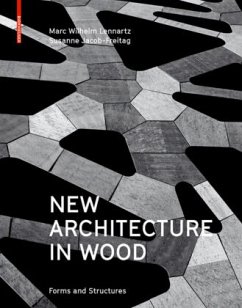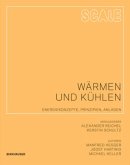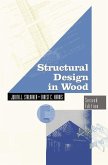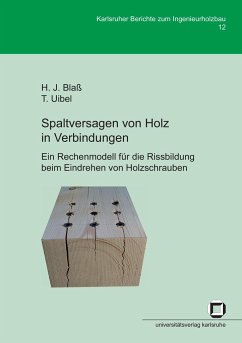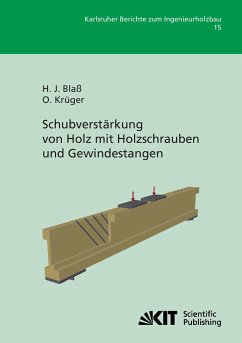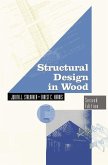Timber: the old raw material and building material returns.There are many reasons today for building with wood and there are great advantages over conventional designs. Wood is not only a renewable building material that helps reduce the levels of CO2 and is hence good for climate change, but, due to modern computing and manufacturing processes, it can also be used for a variety of construction tasks. Wood possesses excellent qualities for both construction and indoor climate control, and can easily be combined with other common building materials.
Based on 24 international projects, the book provides an overview of the range of possibilities in wood construction today. Texts, images, and plans document the architectural and constructive qualities of contemporary timber structures from the conceptual design to the structure in detail.
The various uses are based on current research in modern timber engineering but also on timber construction expertise that has been developing over many centuries. This special discipline has evolved significantly in recent decades, particularly in Germany, Austria, and Switzerland, and is a world leader today.
Das neue Bauen mit Holz hat vielfältige Gründe und Vorteile gegenüber konventionellen Bauweisen: Holz ist ein nachwachsender Baustoff und hilft als CO2-Senke beim Klimaschutz, zugleich ist er dank moderner Berechnungs- und Fertigungsverfahren für zahlreiche Bauaufgaben einsetzbar. Holz weist hervorragende konstruktive wie raumklimatische Eigenschaften auf und lässt sich problemlos mit sämtlichen anderen, gängigen Baumaterialien kombinieren.
Dieses Fachbuch gibt anhand von 24 internationalen Projekten einen Überblick über die derzeit realisierte Vielfalt an Möglichkeiten im modernen Holzbau. Die Beiträge dokumentieren in Texten, Bildern und Plänen sowohl die architektonischen als auch die konstruktiven Qualitäten zeitgemäßer Holzbauten, von der Entwurfsplanung über das Tragwerk bis ins Detail.
Die vielfältigen Einsatzbereiche beruhen dabei auf einer in Jahrhunderten aufgebauten, holzbaulichen Expertise sowie auf aktuellen Forschungen im modernen Ingenieurholzbau. Diese Spezialdisziplin hat sich in den letzten Jahrzehnten besonders in Deutschland, Österreich und der Schweiz signifikant weiterentwickelt und ist heute weltweit führend.
Hinweis: Dieser Artikel kann nur an eine deutsche Lieferadresse ausgeliefert werden.
Based on 24 international projects, the book provides an overview of the range of possibilities in wood construction today. Texts, images, and plans document the architectural and constructive qualities of contemporary timber structures from the conceptual design to the structure in detail.
The various uses are based on current research in modern timber engineering but also on timber construction expertise that has been developing over many centuries. This special discipline has evolved significantly in recent decades, particularly in Germany, Austria, and Switzerland, and is a world leader today.
Das neue Bauen mit Holz hat vielfältige Gründe und Vorteile gegenüber konventionellen Bauweisen: Holz ist ein nachwachsender Baustoff und hilft als CO2-Senke beim Klimaschutz, zugleich ist er dank moderner Berechnungs- und Fertigungsverfahren für zahlreiche Bauaufgaben einsetzbar. Holz weist hervorragende konstruktive wie raumklimatische Eigenschaften auf und lässt sich problemlos mit sämtlichen anderen, gängigen Baumaterialien kombinieren.
Dieses Fachbuch gibt anhand von 24 internationalen Projekten einen Überblick über die derzeit realisierte Vielfalt an Möglichkeiten im modernen Holzbau. Die Beiträge dokumentieren in Texten, Bildern und Plänen sowohl die architektonischen als auch die konstruktiven Qualitäten zeitgemäßer Holzbauten, von der Entwurfsplanung über das Tragwerk bis ins Detail.
Die vielfältigen Einsatzbereiche beruhen dabei auf einer in Jahrhunderten aufgebauten, holzbaulichen Expertise sowie auf aktuellen Forschungen im modernen Ingenieurholzbau. Diese Spezialdisziplin hat sich in den letzten Jahrzehnten besonders in Deutschland, Österreich und der Schweiz signifikant weiterentwickelt und ist heute weltweit führend.
Hinweis: Dieser Artikel kann nur an eine deutsche Lieferadresse ausgeliefert werden.

